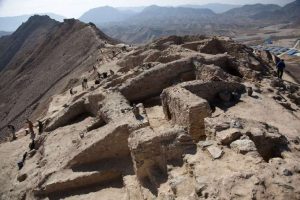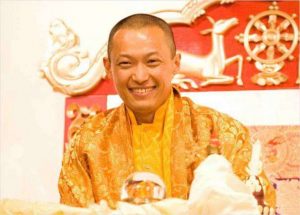
From 25 May to 4 June, John Cannon and Jnan Nanda traveled to Bangladesh to visit friends and Buddhist temples, including ancient archaeological sites in different parts of the country. They criss-crossed eight districts, covering Dhaka, Chittagong, Rangamati, Bandarban, Ramu in Cox’s Bazar, Comilla, Bogra and Naogaon. As Buddhists, they interacted with the local Buddhist communities, and hope that by sharing their experiences through articles and videos they will promote understanding and appreciation of the little-known Buddhist communities and country of Bangladesh.
Darkness falls early in Rangamati. It was 27 May, our second day in Bangladesh. We had arrived early the night before at Jnan’s home village of Bharoghoniya Tanchangya Para (Tanchangya also refers to the ethnicity of the villagers), which lies just beyond the border between the Chittagong Plains and the Chittagong Hill Tracts (CHT) in Rangamati District. We had left Dhaka on 25 May by the overnight bus to Chittagong followed by a two-hour drive by car to the village.
We had spent the day at Jnan’s family farm and roamed around the nearby fields. In the growing darkness, we headed back to Gyanodhoi Buddhist Vihara because Jnan and I wanted to have a chat with the laity observing uposatha, held on the new and full moon days each month. Only the lights coming from the houses on our left and right and from our torches illuminated the winding path to the village temple. We stopped from time to time to greet villagers returning from a back-breaking day’s work in the fields, carrying farm implements or vegetables and fruit to take home for that evening’s meal or, perhaps, to sell at the local market the next day. Some farmers or their children were leading the cows (goru) back to their enclosures after a day’s grazing on the open fields.
I noticed one building on my right that was brightly lit. Through the open door, a Muslim was busy with his evening prayers. I was told this was newly built, and served as a mosque for the Muslims living in the village. Off in the distance I could hear the monks chanting, which slowly became louder as we approached the temple.
The village temple is small, with the main shrine hall facing you as you ascend the steps from the path. The monks’ living quarters are to the left, while a separate building, the old temple, to the right consists of a hall and two rooms, one for cooking and one for the laity to gather in. I believe the two lay temple assistants, Manik and Oosasin, also have their sleeping quarters in that building. At the time of our visit, there were three monks and two novices in residence.
Entering the temple, we immediately noticed the Buddha image directly in front. A large refrigerator donated by Jnan and myself in early May was placed against the wall on the right to store drinks and food for the monks and guests. Off to the left were chairs for the monks—the others would sit on the floor.
Standing in the doorway of the temple, I saw two groups of people dressed all in white sitting on the floor meditating in front of the Buddha image. There were five men and five women, with the men on the left and the women on the right. They were farmers, doctors, and teachers, and the average age of the men was 50 to 80 years old. They had arrived at the temple early that morning, and would stay overnight to observe uposatha with the monks.
After going for a shower and a meal, I returned and sat at the back of the hall, observing the laity doing their meditation and waiting for the opportunity to chat with the male villagers. In the silence, as I observed my breath coming in and going out, the sound of the calendar flicking against the wall, the whirl of the fans, and the shrill of the insects outside calling into the night arose in my consciousness. The ambience was tranquil—perfect for meditation and quiet reflection.
After the meditation session, facing the five aged villagers, our conversation began.
Q: What are the uposatha activities at the temple for the lay people?
We will be at the temple for 24 hours, staying overnight. On some occasions we stay at the temple for one week. We wear white to indicate that during uposatha we will observe Buddhist norms and take the Eight Precepts. [Note: the additional three precepts beyond the basic five include refraining from wearing jewelry/cosmetics/perfume; refraining from eating after the midday meal; and refraining from sleeping on a high, luxurious bed.]
Under the guidance of the monks, we chant, do vipassana meditation, and listen to Dhamma talks.
Q: Looking around, I notice that males and females are in separate groups. Any special reason?
Purely for privacy and convenience. We men have our own affairs to discuss and the women have theirs!
Q: All of you here are rather “mature”—there are no young people celebrating uposatha. Why?
Yes, you’re right, but young people will attend on other uposatha days. Sometimes family obligations prevent young people from attending; they have jobs, and some are studying while others are busy farming until nightfall. Those here tonight are retired, so we have the most free time. Also, in celebrating uposatha we can transfer merit to our absent family members.
Q: What are your expectations towards the monks at the temple?
We would like the monks to guide us along the righteous path, mostly with regards to the religious aspects. Monks can give us spiritual guidance and Dhamma talks, lead us in chanting and guide our meditation.
Q: I have heard about clashes between Buddhists and Muslims in the Chittagong Hill Tracts. How does the government treat Buddhists in this region, who are a minority religious community in Bangladesh?
We must look at this issue from different levels depending on location. Our village is just at the border of the CHT and the Chittagong Plains. Here, our interaction with Muslims and government officials has been mostly peaceful. We have lived side by side with Muslims for generations.
Yes, there have been intermittent clashes but they have ended in peace. We could work out our differences and lead a generally harmonious existence. The major financing of this temple comes from the government.
The government does not exert much pressure here, but the further you go into the CHT, so many clashes between the indigenous people and recent Muslim settlers have broken out and needed to be handled by senior administrative members. There have been several incidents of settlers grabbing land from the indigenous people. In some areas, indigenous people have had to flee their homes out of fear for their lives.
Generally, here in our district the government gives help and occasional pressure, but in other areas the government’s pressure can be quite heavy.
After our friendly discussion, the villagers prepared themselves to hear a Dhamma talk from one of the monks. Quietly, I returned to my room, where some of the younger monks and the temple assistants were waiting to chat with me and take advantage of the television in my room to watch cricket.






